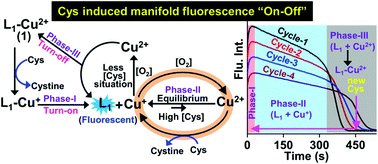A unique cysteine selective water soluble fluorescent probe operable in multiple sensing cycles for the detection of biogenic cysteine in multicellular living species†
Abstract
The Schiff base ligand (L1) showing large fluorescence intensity in an aqueous medium owing to a ground state intramolecular proton transfer (GSIPT) reaction was utilized in a complexation process to generate a highly stable non-fluorescent Cu(II)/L1 (1) in its “turn-off” mode. The 3:2 Cu(II)/L1 stoichiometric complex (1), isolated in the solid form, exhibited a cysteine (Cys)-induced “turn-on” fluorescence response with a unique time-dependent intensity variation. Unlike other biothiols, the partially deprotonated –SH moiety in Cys is highly susceptible for participating in an ionic interaction with Cu(II)-centres in 1 at a physiological pH of ∼7.4, followed by reduction to Cu(I), and then a subsequent demetallation, resulting in a large increment of the fluorescence intensity for free fluorophoric L1, which persists for about 4 –13 min owing to an unexpected stability of the Cu(I) ions. After Cys consumption, Cu(I) ions in aqueous solution rapidly oxidize to participate further in complexation with the existing free L1. The resulting complex may again be susceptible to Cys-induced abovementioned decomplexation followed by complexation for at least four different external Cys additions in four successive cyclic pathways. This multiple Cys sensing behaviour has been exploited to recognize the existence of Cys in multicellular Caenorhabditis elegans (C. elegans).



 Please wait while we load your content...
Please wait while we load your content...